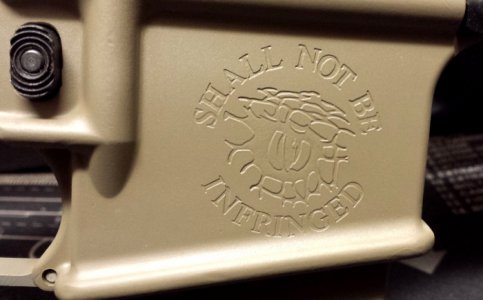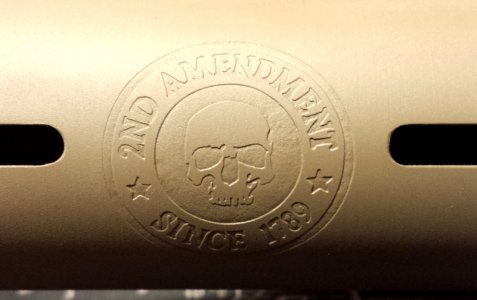-
Welcome back Guest! Did you know you can mentor other members here at H-M? If not, please check out our Relaunch of Hobby Machinist Mentoring Program!
You are using an out of date browser. It may not display this or other websites correctly.
You should upgrade or use an alternative browser.
You should upgrade or use an alternative browser.
Ar15 Lower: Jumping In
- Thread starter n3480h
- Start date
- Joined
- Jul 30, 2012
- Messages
- 500
That turned out great!! I've got to break mine out soon to etch my Form 1 can. It's a little scary because it's so simple. I kept thinking I had to be doing something wrong.
Love the designs too.
Love the designs too.
- Joined
- Jul 30, 2012
- Messages
- 500
Remember to put "Shut up. I keel you!" under Achmed.
- Joined
- Dec 22, 2012
- Messages
- 328
Did Cerakote for the first time today, using a Paasche VL airbrush. Tip size was a #3, but a #5 might have been better. Mixed up about 1/2 of the "refill" size kit, or about 2 ounces. Baked the plastic grip at 170°F for 2 hours, and the aluminum parts at 250°F for 2 hours. Finish is pretty consistent. All parts were sandblasted and cleaned before spraying. The etching still shows up pretty well, although I would have liked the freefloat logos a little deeper. I'm satisfied with this first effort of new processes. Still have to make a brake and get the Luth butt stock. Got a blizzard tonight, so it'll be a few days before things warm up enough to try out some 300 loads.
Tom



Tom



- Joined
- Jul 30, 2012
- Messages
- 500
That turned out great!
- Joined
- Dec 22, 2012
- Messages
- 328
For those who may be curious, I formed and loaded some 300 supersonic rounds today. LC brass was cut to length on the lathe, verified with a height gage, and then prepped on a CaseMate. Using Hodgden's starting load for 110gr Nosler BT bullets, H110 powder, and magnum primers, I had great success with these trial loads. Every charge was weighed at 18.8 grains. I was focused on function and safety today since essentially all the parts on this rifle are new. I had excellent feeding, sufficient energy to drive the bolt, no auto fire (whew!), and consistent bolt lock back with the final round in the magazines. All spent brass ended up within a very small pile. No signs of over pressure in the brass or the primers. All in all, the rifle functioned perfectly. The one negative today was that the case mouths were slightly deformed during ejection by the upper's case deflector - easy enough to fix with a small piece of self-adhesive Velcro on the deflector.
Now, on to the important stuff: This rifle is incredibly fun to shoot. Recoil is light and the round is not nearly as loud as my Armalite in .223. I can't wait to try some subsonics with a 220 grain bullet, and eventually a suppressor. In my opinion, the 300 Blackout round is a winner.
Tom
Now, on to the important stuff: This rifle is incredibly fun to shoot. Recoil is light and the round is not nearly as loud as my Armalite in .223. I can't wait to try some subsonics with a 220 grain bullet, and eventually a suppressor. In my opinion, the 300 Blackout round is a winner.
Tom
- Joined
- Apr 6, 2011
- Messages
- 2,082
300 BLK is my next build but now I've just got to consider etching it. 
-Ron
-Ron
- Joined
- Dec 22, 2012
- Messages
- 328
300 BLK is my next build but now I've just got to consider etching it.
-Ron
Ron, I hope you will. Etching opens up a lot of possibilities in personalizing our rifles. My experience taught me to minimize very small detail (hard to cut and pick the vinyl) and etch at least .005" deep if you etch before sandblasting. I will try etching a piece of scrap after sandblasting to see if that works better for me on the next build. Though etching takes some patience, the result is well worth the time and effort. The fact that this method is essentially free . . . .well that's just gravy.
Tom


